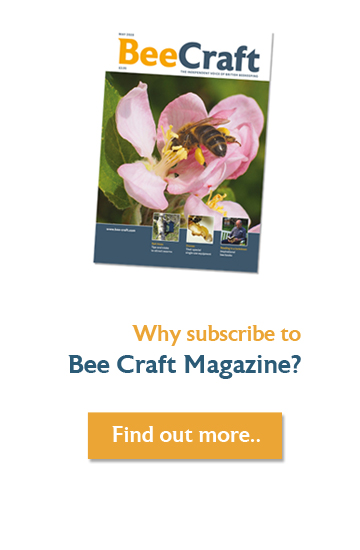By Adrian Waring, NDB
Swarm control is what you do to a colony of honey bees that has actually started swarming preparations – if you want to stop the swarm issuing.
How do you know when to intervene?
By making regular examinations of the brood nest. These examinations must be brief but thorough enough to find queen cells with eggs or tiny larvae in them.
How regular must the examinations be?
Although nothing is totally rigid, bees usually swarm when the oldest queen cell is sealed. This is nine days after the egg it contains was laid. Since we live our lives on a seven-day cycle, it is more convenient to look every seven days from April to early July. The earliest dates are for the far south of the country and the latest for northern areas.
It is important to know the life stages and their duration for both the queen and workers.

Even on a seven-day inspection cycle, a missed queen cell can be a disaster. Tiny larvae, both queen and worker, can be developed into a sealed queen cell in less than a week. So, look carefully! A day-old larva will be in a sealed queen cell only five days later!
Hopefully, you find only eggs or tiny larvae in your queen cells. Do something now. If you want to try delaying tactics, you are on your own. Swarm control tactics work best when done at the right time, ie, immediately.
Method and equipment
You must also have a method in mind and enough equipment to put it into practice. Real problems only occur when you don’t have enough equipment. For the following method, you will need a floor, brood box with frames of drawn comb or foundation, and an inner cover and roof.
If there are only unsealed queen cells, proceed as follows:
- Move the whole colony to one side. Don’t mix up the brood box and super(s). Keep them separate. A queen in the supers is very undesirable!
- Put the new floor and brood box on the old site.
- Remove one or two frames from the new box.
- From the old brood box, remove a comb of brood in all stages but without any queen cells. Remove any queen cells on that comb if it makes life easier.
- Place this frame in the gap you have created in the new box. You can put in another frame of brood if you wish. Fill up the spaces.
- Put the queen excluder on top of this new box.
- Put the supers from the original colony on top of the excluder, followed by the inner cover and roof.
- In the original brood box, push all the frames up together and fill up the gap(s) with the frame(s) displaced from the new box.
- Move this box elsewhere in the apiary. It needs to be at least 2 m (6 ft) away from the original site, with the entranced turned through 90°, away from the original position.
During the next week, the flying bees will return to the original site. If the queen is in the old box, the bees will tear down the queen cells and the bees in the new box will build queen cells. If the queen was on the comb of brood you left new box on the old site, you will have performed the ‘classic’ artificial swarm without finding the queen.
You will know which box the queen is in at this point because there will be no queen cells and you will find eggs laid in worker cells. If there are no queen cells on the combs you moved into the new brood box, you have, as I said, created an artificial swarm.
Reduce the queen cells
In the box which has the queen cells, you need to reduce them to one. In most cases, they will be on the one or two combs you transferred into the new box as it is likely that the queen will be with the majority of the brood nest in the old box.
As soon as the new queen emerges from the cell you left and starts to lay, add combs of brood from the box with the old queen, swapping them with empty combs from the new queen’s colony, if this is feasible. The aim is to build up the brood nest in the box housing the new queen.
The box containing the old queen may well need supering. You must keep your eye on it!
The number of colonies you have can be reduced to the number you want later in the year by uniting. Only overwinter the number of colonies you can feed properly.




